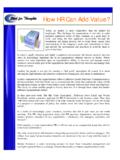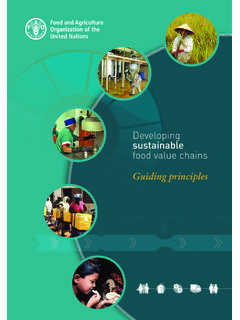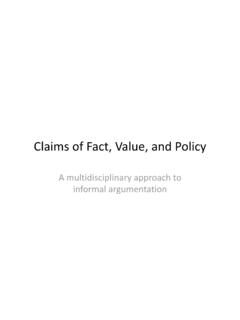Transcription of Value Chain for Services - Refined- for web - …
1 Value Chain for Services A new dimension of Porter s Value Chain (Published in the IMS International Journal 2006) By Prof. Elisante ole Gabriel (PhD, Marketing) Lecturer Mzumbe University Faculty of Commerce, P O Box 6, Mzumbe, Morogoro, Tanzania Visiting Professor of; Strategic Marketing & Management Finland, India, Australia & Kenya Email: Mobile Tel. +255-784-455499, Fax +255-732-979949 Private Website: 2 Biography of the Author Elisante Gabriel Elisante Gabriel is currently a faculty member Mzumbe University under the faculty of Commerce.
2 Previously, at the time of publishing this article, he has been working with The Institute of Finance Management (IFM), under the Directorate of Graduate School. At IFM, Elisante was The Head of the department of Executive Development, Research & Consultancy. He also lectures to Masters programmes in International Business. He teaches the following subjects to Masters Programmes; Marketing, International Marketing, Competitive strategies, Strategic Management, Consumer Behaviour and Organizational Behaviour.
3 Before joining the PhD programme at Salford University (in 2000), Elisante was working with Pricewaterhousecoopers (Tanzania) as a senior Business Analyst. He also taught a subject called Purchasing and Supplies at the University of Salford in the department of Accounting, Economics and Management Sciences, in 2001. To date Elisante has a working experience of more than twelve years in various organizations ranging from manufacturing to service sector. He is looking forward to developing and managing changes in a competitive business environment around the world.
4 His research area of interest is focused on creating and communicating the Value for achieving a sustainable competitive advantage. He believes that co-creation of meaning and Value is among the best tools in creating, sustaining and satisfying existing and prospective customers. Elisante completed his Masters of Science degree (International Business) at the University of Salford in 1999. Prior to his Masters degree, Elisante studied other various programmes including: Business Administration, Marketing, Accountancy, Materials Management and Mechanical Engineering (specialisation Manufacturing).
5 He is a member of the following professional institutions: Chartered Institute of Marketing (London UK), National Board of Accountants and Auditors (Tanzania), National Board for Materials Management (Tanzania) and Institution of Engineers Tanzania. 3 Abstract For many decades marketers have been considering service as a separate concept from product . With the inception and growth of the service sector around the globe, there is a significant growth of marketing of Services . In deed, now we have to perceive service as a product with different characteristics from the physical product.
6 The physical products are tangible while the Services are intangible. For this peculiar difference, the Value chains of these two categories of products (tangible and intangible) ought to be different though might have a relationship. Professor Michael Porter has developed a Value Chain with five primary activities and four supporting activities. The said Value Chain is very applicable to the manufacturing sector but, as it is, the model cannot be used directly in the service sector. The author of this article contacted Professor Porter, who is the founder of Porters Value Chain model, about the said shortcomings of the model.
7 On his (Porter) reply by email dated 17th July 2003 (see Exhibit 2), he admitted that they did not consider the service sector in depth when developing the said Value Chain . When the author conducted a research on Higher Education sector, he sent same challenge to Prof. Philip Kotler, in order to get his comments about the Porter s Value Chain . Kotler responded to that challenge and appreciated the need of new development, insisting that there ought to be different Value chains depending on the target market (see Exhibit 1).
8 This article will make a development of what ought to be a new dimension of the Value Chain , which will cater for the service sector. Porter s Value Chain will be used as a reference to build another Value Chain for Services . A discussion on the Value management, co-creation and delivery of Value will form part of this article. A case of Higher Education sector of Tanzania will be used as a reference case in building a concrete situation for a general Value Chain for Services . Characteristics of Services will also be discussed.
9 A new model of Value Chain and a discussion on the need of total quality management to achieve a competitive advantage in service competition will form the last part of the article. The author is highly motivated to write this article to support his belief in marketing. He (author) believes that: Customers are not and will never be buying products but values . 4 Introduction to Value Management There are various definitions of Value by different gurus. I wish to give a definition of Value as follows: The customer s perception about whole bundle of benefits, being tangible or intangible, which satisfy the needs of the customer timely, effectively and efficiently.
10 It must be borne in mind that the satisfaction ought to be from the customer s point of view. Value is always and will continue to be subjective, since what satisfies customer X, might dissatisfy customer B. Not all Customers are Equal. Perhaps the most important rule of marketing is the Rule of Focus. No matter what size your company is, any attempt to serve too many diverse needs is not sustainable. Therefore, the Rule of Focus forces you to identify and serve the customers whom you can do your best and give Value -for-money.






